|
|
|
Sort Order |
|
|
|
Items / Page
|
|
|
|
|
|
|
| Srl | Item |
| 1 |
ID:
120790
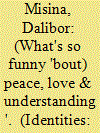

|
|
|
|
|
| Publication |
2013.
|
| Summary/Abstract |
The article examines current rock culture in the Balkans as a potential vehicle for rebuilding the broken sociocultural bonds between the different post-Yugoslav societies and for creating a constructive cultural space for articulating new forms of civic and post-nationalist identities. The argument offered is that, after the sociocultural exile during the war years, rock culture in the post-conflict Balkans has considerable potential to establish itself as a popular-cultural force of 'utopian transcendence' of the current ethno-nationalist sociopolitical moment, and as a catalyst of the new post-Yugoslav spirit of openness, tolerance and peaceful coexistence.
|
|
|
|
|
|
|
|
|
|
|
|
|
|
|
|
| 2 |
ID:
117632
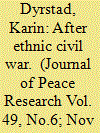

|
|
|
|
|
| Publication |
2012.
|
| Summary/Abstract |
While the study of the causes of civil war is a well-established subdiscipline in international relations, the effects of civil war on society remain less understood. Yet, such effects could have crucial implications for long-term stability and democracy in a country after the reaching of a peace agreement. This article contributes to the understanding of the effects of warfare on interethnic relations, notably attitudes of ethno-nationalism. Two hypotheses are tested: first, that the prevalence of ethno-nationalism is higher after than before the war, and second, that individuals who have been directly affected by the war are more nationalist than others. The variation in ethno-nationalism is examined over time, between countries, and between ethnic groups. Three countries that did not experience conflict on their own territory serve as a control group. The effect of individual war exposure is also tested in the analysis. Sources include survey data from the former Yugoslavia in 1989, shortly before the outbreak of war in Croatia and Bosnia and Herzegovina, and in 2003, some years after the violence in the region ended. Contrary to common beliefs, the study shows that ethno-nationalism does not necessarily increase with ethnic civil war. The individual war experiences are less important than expected.
|
|
|
|
|
|
|
|
|
|
|
|
|
|
|
|
| 3 |
ID:
099837
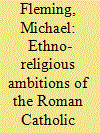

|
|
|
|
|
| Publication |
2010.
|
| Summary/Abstract |
This paper differentiates between centrifugal and centripetal aspects of ethno-nationalism to help account for the ascendancy of communism in the immediate aftermath of World War II in Poland. It argues that the directing of social antipathy to defined out-groups allowed the Polish Workers' Party (PPR) to manage social anger and that the Roman Catholic Church's ethno-religious agenda was aligned with the PPR's ethno-nationalist policy. Furthermore, it is contended that the Church's toleration of hostile actions directed at minority communities supported the PPR's management of social anger. The paper concludes that the Church, despite its manifest intentions and contrary to contemporary perceptions, played a role in the PPR's achievement of hegemony.
|
|
|
|
|
|
|
|
|
|
|
|
|
|
|
|
| 4 |
ID:
178068
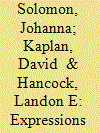

|
|
|
|
|
| Summary/Abstract |
This paper poses three related questions. What is white ethno-nationalism as it exists today within the United States, how is this sentiment expressed by particular organizations, and how is it expressed by ordinary people who belong to these organizations? We begin what ethno-nationalism signifies and its relation to other forms of nationalism. We then check how certain indicators are present among supporters of an organization, Blue Lives Matter, which emerged as a reaction to Black Lives Matter. While this movement has framed itself as supportive of police rights, its negative reaction to Black Lives Matter has become a vehicle to express white ethno-nationalism. These views are gauged as a means to understanding the contours of banal white ethnonationalism as opposed to those more strident forms registered by neo-Nazis and KKK members.
|
|
|
|
|
|
|
|
|
|
|
|
|
|
|
|
| 5 |
ID:
047551
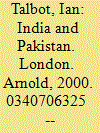

|
|
|
|
|
| Publication |
London, Arnold, 2000.
|
| Description |
xxi, 312p.
|
| Standard Number |
0340706325
|
|
|
|
|
|
|
|
|
|
|
|
Copies: C:1/I:0,R:0,Q:0
Circulation
| Accession# | Call# | Current Location | Status | Policy | Location |
| 043477 | 327.5405491/TAL 043477 | Main | On Shelf | General | |
|
|
|
|
| 6 |
ID:
107082
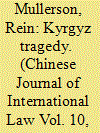

|
|
|
|
|
| Publication |
2011.
|
| Summary/Abstract |
In June 2010, a bloody conflict took place in southern Kyrgyzstan. In inter-ethnic clashes, more than 470 people were killed, and more than 110 000 became refugees. The Independent International Commission, of which the author was one of seven members, found that certain attacks against Uzbeks might constitute crimes against humanity. The article analyses the political context of the crisis, the role of ethno-nationalism in its genesis as well as difficulties and challenges the Government and people of Kyrgyzstan face in building an inclusive society where all ethnicities feel at home. The article scrutinizes the June events and following developments in the light of international, including human rights, law. Comparative analysis allows a singling-out of what in the Kyrgyz crisis may be specific for this country and what lessons other societies may learn to avoid similar conflicts.
|
|
|
|
|
|
|
|
|
|
|
|
|
|
|
|
| 7 |
ID:
121473
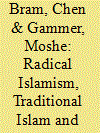

|
|
|
|
|
| Publication |
2013.
|
| Summary/Abstract |
This study examines the interplay between Islam and collective identity and their position in potential conflicts by exploring the dynamics of Islam, ethno-nationalism and civic society within different parts of the Northern Caucasus. Historical and anthropological approaches are used for a comparative analysis of Daghestan and Chechnya in the east and of Kabardino-Balkaria and Karachai-Cherkesia in the west. The study demonstrates the importance of local context and historical background to the understanding of ethnicity, nationalism, civic identity and their interplay with Islam. The analysis highlights that the different history and socio-cultural characteristics of the different regions in question leads to different approaches to religion which contain a paradox. In Daghestan and Chechnya, Islam is well established and the authorities have to collaborate with different Islamic bodies in their struggle against 'Wahhabism'. In Kabardino-Balkaria and Karachai-Cherkesia the 'legitimate' Islamic leaders - whether those representing the state or leaders of other Islamic movements - are powerless. While this represents the overall weak position of Islam in these areas, paradoxically it also opens options for radical Islamists to gain support, in the context of economic hardships, weakening of other sources of identification, and corruption. This process is generated and fostered by policies that limit ethno-nationalism and expand the struggle against radicalism to a struggle against religious activity in general. The Northern Caucasus has often been perceived as a major locus of radical Islam, and as a strategic rift in the 'clash of civilizations'. This study claims that the significant rifts and conflicts are between different Islamic alternatives. Important variables crucial to this discussion highlighted by the case of the Northern Caucasus are ethnicity, nationalism, civic identity and their interplay with Islam. At the same time, this case also highlights that the potential of radicalism in Islamic societies is not the mere result of its own 'characteristics', but is also a product of policy towards Islamic societies by outside actors, in this case Russia.
|
|
|
|
|
|
|
|
|
|
|
|
|
|
|
|
| 8 |
ID:
137217
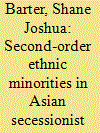

|
|
|
|
|
| Summary/Abstract |
This article provides some conceptual foundations for a special issue of Asian Ethnicity concerned with what we call ‘second-order minorities’. If secessionist conflicts involve minorities resisting abusive, assimilationist states, leading rebel groups to embark on their own nation-building efforts, how does this affect the minorities of aspiring secessionist nations? How do the minorities of secessionist groups respond to secessionism? Despite many insightful studies of secessionism and rebel ethno-nationalism, scholars have yet to explore the ways that local minorities navigate secessionist conflicts. We suggest that the relationship between secessionists and second-order minorities depends on three key factors: whether minorities are territorially concentrated or dispersed, indigenous or migrant, and nation majorities or small national minorities. These characteristics provide us some idea of the types of violence and counter-mobilization we might see among second-order minorities faced with secessionist violence. This article then previews the subsequent studies of Xinjiang, Aceh, Mindanao, and Sri Lanka, cases which capture some of the core challenges faced by second-order minorities against twin violent nation-building efforts from state and rebel forces.
|
|
|
|
|
|
|
|
|
|
|
|
|
|
|
|
| 9 |
ID:
102824
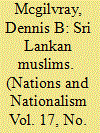

|
|
|
|
|
| Publication |
2011.
|
| Summary/Abstract |
Sri Lanka's Sunni Muslims or "Moors", who make up eight percent of the population, are the country's third largest ethnic group, after the Buddhist Sinhalese (seventy-four per cent) and the Hindu Tamils (eighteen per cent). Although the armed LTTE (Tamil Tiger) rebel movement was defeated militarily by government forces in May 2009, the island's Muslims still face the long-standing external threats of ethno-linguistic Tamil nationalism and pro-Sinhala Buddhist government land and resettlement policies. In addition, during the past decade a sharp internal conflict has arisen within the Sri Lankan Muslim community between locally popular Sufi sheiks and the followers of hostile Islamic reformist movements energised by ideas and resources from the global ummah, or world community of Muslims. This simultaneous combination of "external" ethno-nationalist rivalries and "internal" Islamic doctrinal conflict has placed Sri Lanka's Muslims in a double bind: how to defend against Tamil and Sinhalese ethnic hegemonies while not appearing to embrace an Islamist or jihadist agenda. This article first traces the historical development of Sri Lankan Muslim identity in the context of twentieth-century Sri Lankan nationalism and the south Indian Dravidian movement, then examines the recent anti-Sufi violence that threatens to divide the Sri Lankan Muslim community today.
|
|
|
|
|
|
|
|
|
|
|
|
|
|
|
|
| 10 |
ID:
140125
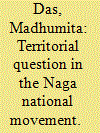

|
|
|
|
|
| Summary/Abstract |
The article concerns itself with the current phase of the Indo-Naga peace talks, seemingly rendered intransigent on the contentious issue of administrative integration of contiguous Naga-inhabited areas. It historically examines the ethno-territoriality of the Naga national movement in the states of Nagaland, Manipur, Assam and Arunachal Pradesh. This article finds that notwithstanding the soundness of the claims, Naga territoriality is not a non-negotiable given but an active construction of the changing politics of the movement. The findings suggest that any proposed federal arrangement should balance ethno-territorial urges with historical peculiarities. A substantial measure of non-territorial autonomy, in a mutually binding federal arrangement, would necessitate a redefinition of both Naga ethno-national aspirations and the post-colonial Indian state’s insecurities. However, it holds the potential for sustainable peace in the region.
|
|
|
|
|
|
|
|
|
|
|
|
|
|
|
|
| 11 |
ID:
120372


|
|
|
|
|
| Publication |
2013.
|
| Summary/Abstract |
This paper examines the state-building project in Kazakhstan since independence in 1991. It argues that both civic and ethno-nationalistic tendencies in state-building can be identified but that it is not any particular trajectory of nationalism in Kazakhstan that is of significance so much as the tensions between two very different trajectories. We argue that, at least to date, the government has succeeded in managing these tensions quite effectively both at the policy level and in its relations with different ethnic groups and neighbouring states. Whether Kazakhstan can continue to manage these tensions in the post-Nazarbayev era is one of the most significant questions facing the country.
|
|
|
|
|
|
|
|
|
|
|
|
|
|
|
|
|
|
|
|
|